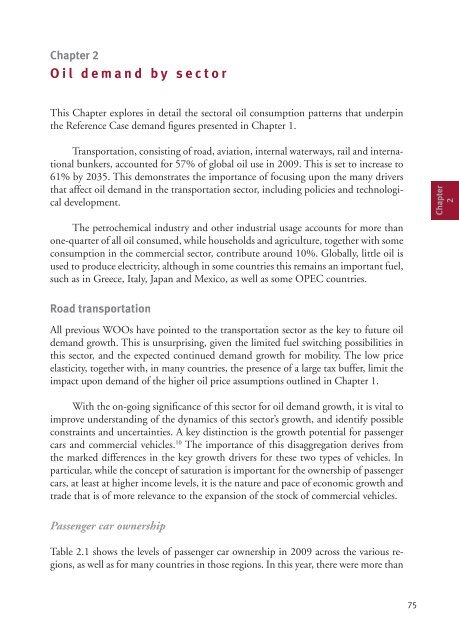World Oil Outlook - Opec
World Oil Outlook - Opec
World Oil Outlook - Opec
- TAGS
- world
- outlook
- opec
- www.opec.org
Create successful ePaper yourself
Turn your PDF publications into a flip-book with our unique Google optimized e-Paper software.
Chapter 2<br />
<strong>Oil</strong> demand by sector<br />
This Chapter explores in detail the sectoral oil consumption patterns that underpin<br />
the Reference Case demand figures presented in Chapter 1.<br />
Transportation, consisting of road, aviation, internal waterways, rail and international<br />
bunkers, accounted for 57% of global oil use in 2009. This is set to increase to<br />
61% by 2035. This demonstrates the importance of focusing upon the many drivers<br />
that affect oil demand in the transportation sector, including policies and technological<br />
development.<br />
The petrochemical industry and other industrial usage accounts for more than<br />
one-quarter of all oil consumed, while households and agriculture, together with some<br />
consumption in the commercial sector, contribute around 10%. Globally, little oil is<br />
used to produce electricity, although in some countries this remains an important fuel,<br />
such as in Greece, Italy, Japan and Mexico, as well as some OPEC countries.<br />
Road transportation<br />
All previous WOOs have pointed to the transportation sector as the key to future oil<br />
demand growth. This is unsurprising, given the limited fuel switching possibilities in<br />
this sector, and the expected continued demand growth for mobility. The low price<br />
elasticity, together with, in many countries, the presence of a large tax buffer, limit the<br />
impact upon demand of the higher oil price assumptions outlined in Chapter 1.<br />
With the on-going significance of this sector for oil demand growth, it is vital to<br />
improve understanding of the dynamics of this sector’s growth, and identify possible<br />
constraints and uncertainties. A key distinction is the growth potential for passenger<br />
cars and commercial vehicles. 10 The importance of this disaggregation derives from<br />
the marked differences in the key growth drivers for these two types of vehicles. In<br />
particular, while the concept of saturation is important for the ownership of passenger<br />
cars, at least at higher income levels, it is the nature and pace of economic growth and<br />
trade that is of more relevance to the expansion of the stock of commercial vehicles.<br />
Passenger car ownership<br />
Table 2.1 shows the levels of passenger car ownership in 2009 across the various regions,<br />
as well as for many countries in those regions. In this year, there were more than<br />
75<br />
Chapter<br />
2
















